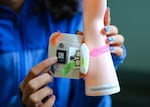Like many innovators, Anushka Naiknaware began with a problem: It's difficult to know the right time to replace bandages for chronic wounds. Unlike many innovators, she came up with a solution to such a difficult problem at the age of 13.
Now an eighth-grader at Stoller Middle School in Beaverton, Naiknaware was awarded the LEGO Education Builder Award at the 2016 International Google Science Fair for her invention. She was the youngest winner in the competition.
Naiknaware first became interested in this problem when she learned that 4.8 million Americans suffer from chronic wounds. The National Center for Biotechnology Information defines chronic wounds as any wound that fails to progress or respond to treatment over the normal expected, time frame for healing.
"It's a very overshadowed topic. So, before I started it I had no idea what a chronic wound was," Naiknaware said. "And I was just kind of shocked, like no one has done anything? It hasn't been addressed?"
Changing the dressing of a wound too often or not often enough delays the healing process and increases the risk of infection. Naiknaware explained that these days health professionals change the dressings every 12 hours regardless of the type of wound. However, not all wounds are the same. Some need new bandages more frequently, and others less frequently.
Naiknaware's solution? Bandages with sensors that detect the amount of moisture in the dressing, so that doctors know when it is time to change.

13-year-old Anushka Naiknaware holds a model of her award-winning smart bandage
Allison Frost / OPB
After researching various manufacturing options for the sensors, she decided using Inkjet printers would be the cheapest way to produce these sensors. From there, she used carbon nanoparticles to create a conductive, water-based ink to fill the Inkjet cartridges. By printing the sensors using this ink, Naiknaware figured out a simple, harmless and cost-effective way to create moisture sensors for bandages.
Naiknaware says achieving a spot alongside finalists at the Google Science Fair was a very exciting experience. She was flown out to Google's headquarters in Mountain View, California, where she met 15 other finalists.
"The interesting part about meeting people from around the world is that you get to see different perspectives," she said. "So, for example if they're from an underdeveloped country, they have a completely different perspective on what are the problems, and how they go about solving them, and what they consider a science fair."
Naiknaware has always had a profound fascination in science. She recalls how as a child her parents would take her to the Oregon Museum of Science and Industry (OMSI), where she spent hours on experiments in the chemistry lab.
Another early influence that motivated her to pursue science was reading Marie Curie's biography. She says she was inspired by Curie's courage to pursue science at a time when not many women were involved in the field. She hopes that today's young women will follow her example by challenging the idea that the sciences are for men.
"If you prove yourself, all those barriers come crashing down," Naiknaware says. "That's kind of where I want to see all of my peers that are girls. Get into STEM (science, technology, engineering and math) and you can prove them wrong."
Before she graduates high school, Naiknaware hopes to turn her idea into a reality. LEGO has given her a one-year mentorship to help get her project off the ground, but she has a lot of hard work ahead. She will have to get the materials cleared, conduct safe clinical trials, get approval from the Federal Drug Administration, and finally figure out where to mass-manufacture the sensors.
In terms of lifelong goals, Naiknaware hopes to win a Nobel prize in one of the sciences some day. She is definitely off to a good start.
